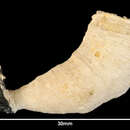en
names in breadcrumbs


"Balanophyllia malouinensis Squires, 1961
Balanophyllia cornu; Gardiner, 1939, pp. 335, 336.
Balanophyllia malouinensis Squires, 1961, pp. 15, 39, 40, 46, figs. 5, 24-26; 1969, pp. 17, 18, pi. 6, map 2.—Sorauf and Podoff, 1977, pp. 4-6, pi. 2, figs. 5, 6, pi. 3, fig. 6, pi. 4, figs. 2-5.—Cairns, 1979, p. 206.
Description. Corallum ceratoid to subcylindrical, straight to slightly curved, usually free when adult. Basal disc diameter about 4.2 mm, narrowing slightly to PD of about 3.5 mm, then gradually expanding into ceratoid corallum. Some coralla, however, subcylindrical and remaining firmly attached by strengthening base with layers of stereome, up to 12 mm in diameter. Young coralla usually weakly attached to epitheca of same species, F. curvatum, small gastropods, bivalves, or pebbles. Largest specimen examined 23.1 x 21.2 mm in CD and 57.5 mm tall. Synapticulotheca thick, very porous, and spinose. Costal spines usually
randomly arranged, but in some specimens aligned longitudinally and separated by striae, resembling costae. Between 60 and 100% of synapticulotheca covered by thin, irregularly banded epitheca, of ten leaving only small ring of synapticulotheca visible at calicular edge. According to Sorauf and Podoff (1977), synapticulotheca gradually in filled by stereome, forming more solid 'stereotheca1’ (Plate 16, fig. 7). Septa hexamerally arranged in five cycles but only largest specimens with complete fifth cycle. S1 and S2 equal in size and extending to columella. Remaining septa arranged in Pourtalès plan: S4 smallest septa, S5 adjacent to S1 and S2 larger than S3 and extending to columella. Septa not exsert and with straight inner edges. Septal granulation variable, from very sparse (smooth septal faces) to crowded arrangement of tall, blunt granules. Columella discrete, massive, elongate structure, resting in shallow, elliptical fossa; either spongy or composed of numerous twisted ribbons, swirled in clockwise direction. Columella may be granulated.
Discussion. Contrary to Squires's (1961) original description, based on six worn specimens, this species does not have exsert septa and does some times have costae. The presence or absence of costae is the basic difference between Balanophyllia and Thecopsammia, the latter lacking costae. The variable nature of this character in B. malouinensis implies that Thecopsammia may be a junior synonym of Balanophyllia. Contrary to Wells (1956) and Squires (1961), Thecopsammia socialis (type-species of Thecopsammia) has a distinct Pourtalès plan in the adult stage (see Cairns, 1979).
Material. Eltanin sta. 339 (255), USNM 47179; sta. 340 (15), USNM 45671; sta. 346 (1), USNM 47154; sta. 369 (6), USNM 47149; sta. 558 (221), USNM 45672; sta. 740 (103), USNM 47153; sta. 970 (21), USNM 47146; sta. 977 (205), USNM 47148; sta. 1521 (6), USNM 47147; sta. 1536 (12), USNM 47178; sta. 1596 (1), USNM 47155. Hero sta. 715-895 (7), USNM 47177. Vema sta. 14-12 (5), AMNH; sta. 14-18 (1), AMNH; sta. 15-PD3 (9), USNM 47150; sta. 15-PD4 (78), USNM 47151; sta. 15-PD9 (6), AMNH; sta. 15- PD10 (9), USNM 53408, and (24), AMNH; sta. 17-59 (6), USNM 53409, and (11), AMNH. Following WH records (H. Zibrowius, personal communication, 1979): sta. 324/66 (2), sta. 325/66 (1), sta. 330/66 (1), sta. 336/66 (3), sta. 357/66 (2), sta. 359/66 (2), sta. 360/66 (1), sta. 269/71 (4), sta. 210/11 (1) (all WH specimens deposited at ZIZM). Specimens (5) identified as B. cornu by Gardiner (1939), BM 1939.7,20.227-228, 234. Holotype.
Types. The holotype is deposited at the American Museum of Natural History (3368). Type-locality: 52°32'S, 61°15'W (south of East Falkland island); 358 m.
Distribution. Off Tierra del Fuego; off Falkland Islands (Islas Malvinas); Scotia Ridge between Burdwood Bank and South Georgia (Map 13). Squires's (1969) record from off Gough Island unsubstantiated. Depth range: 75-1137 m."
Cairns 1982, pp. 52-54, Plate 16, figs. 4-7; Plate 17, figs. 1-3 Plate 18, fig. 7.